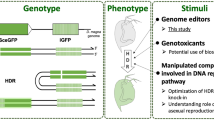Abstract
Daphnids are small crustaceans ubiquitous in fresh water; they have been a subject of study in ecology, evolution, and environmental sciences for decades. To understand data accumulated in daphnid biology at the molecular level, expressed sequence tags and a genome sequence have been determined. However, these discoveries lead to the problem of how to understand the functions of newly discovered genes. Double-stranded RNA (dsRNA)-mediated RNA interference (RNAi) is a useful tool to achieve specific gene silencing in nontransformable species. Hence, we established a technique to inject exogenous materials into ovulated eggs and developed a dsRNA-based RNAi method for Daphnia magna. Eggs were collected just after ovulation and injected with dsRNA specific to the Distal-less (Dll) gene, which functions in appendage development in invertebrates and vertebrates. We found that the dsRNA successfully triggered the degradation of Dll mRNAs, which induced the truncation of the second antenna in a dose-dependent manner. This effect was sequence specific in that: (1) an unrelated dsRNA did not induce any morphological abnormalities and (2) two non-overlapping Dll dsRNAs generated the same phenotype. This is the first report of an RNAi technique in D. magna and, together with the emerging genome sequences, will be useful for advancing knowledge of the molecular biology of daphnids.





Similar content being viewed by others
References
Agar WE (1950) The swimming setae of Daphnia carinata. Q J Microsc Sci 91:353–368
Beermann A, Jay DG, Beeman RW, Hulskamp M, Tautz D, Jurgens G (2001) The Short antennae gene of Tribolium is required for limb development and encodes the orthologue of the Drosophila Distal-less protein. Development 128:287–297
Belles X (2010) Beyond Drosophila: RNAi in vivo and functional genomics in insects. Annu Rev Entomol 55:111–128
Beye M, Hartel S, Hagen A, Hasselmann M, Omholt SW (2002) Specific developmental gene silencing in the honey bee using a homeobox motif. Insect Mol Biol 11:527–532
Brown SJ, Mahaffey JP, Lorenzen MD, Denell RE, Mahaffey JW (1999) Using RNAi to investigate orthologous homeotic gene function during development of distantly related insects. Evol Dev 1:11–15
Cohen SM, Bronner G, Kuttner F, Jurgens G, Jackle H (1989) Distal-less encodes a homoeodomain protein required for limb development in Drosophila. Nature 338:432–434
Cohen SM, Jurgens G (1989) Proximal–distal pattern formation in Drosophila: cell autonomous requirement for Distal-less gene activity in limb development. EMBO J 8:2045–2055
Colbourne JK, Singan VR, Gilbert DG (2005) wFleaBase: the Daphnia genome database. BMC Bioinform 6:45
Copf T, Schroder R, Averof M (2004) Ancestral role of caudal genes in axis elongation and segmentation. Proc Natl Acad Sci USA 101:17711–17715
Elendt BP, Bias WR (1990) Trace nutrient deficiency in Daphnia magna cultured in standard medium for toxicity testing. Effects of the optimization of culture conditions on life history parameters of Daphnia magna. Water Res 24:1157–1167
Hall HG (1978) Hardening of the sea urchin fertilization envelope by peroxidase-catalyzed phenolic coupling of tyrosines. Cell 15:343–355
Hebert PDN (1978) Population biology of Daphnia (Crustacea, Daphnidae). Biol Rev Camb Philos Soc 53:387–426
Hejnol A, Scholtz G (2004) Clonal analysis of Distal-less and engrailed expression patterns during early morphogenesis of uniramous and biramous crustacean limbs. Dev Genes Evol 214:473–485
Kato Y, Kobayashi K, Oda S, Colbourn JK, Tatarazako N, Watanabe H, Iguchi T (2008) Molecular cloning and sexually dimorphic expression of DM-domain genes in Daphnia magna. Genomics 91:94–101
Kato Y, Kobayashi K, Oda S, Tatarazako N, Watanabe H, Iguchi T (2010a) Sequence divergence and expression of a transformer gene in the branchiopod crustacean, Daphnia magna. Genomics 95:160–165
Kato Y, Kobayashi K, Watanabe H, Iguchi T (2010b) Introduction of foreign DNA into the water flea, Daphnia magna, by electroporation. Ecotoxicology 19:589–592
Khila A, Grbic M (2007) Gene silencing in the spider mite Tetranychus urticae: dsRNA and siRNA parental silencing of the Distal-less gene. Dev Genes Evol 217:241–251
LaCount DJ, Bruse S, Hill KL, Donelson JE (2000) Double-stranded RNA interference in Trypanosoma brucei using head-to-head promoters. Mol Biochem Parasitol 111:67–76
Liubicich DM, Serano JM, Pavlopoulos A, Kontarakis Z, Protas ME, Kwan E, Chatterjee S, Tran KD, Averof M, Patel NH (2009) Knockdown of Parhyale Ultrabithorax recapitulates evolutionary changes in crustacean appendage morphology. Proc Natl Acad Sci USA 106:13892–13896
Lohmann JU, Endl I, Bosch TC (1999) Silencing of developmental genes in Hydra. Dev Biol 214:211–214
Ma Y, Creanga A, Lum L, Beachy PA (2006) Prevalence of off-target effects in Drosophila RNA interference screens. Nature 443:359–363
Miyawaki K, Mito T, Sarashina I, Zhang H, Shinmyo Y, Ohuchi H, Noji S (2004) Involvement of Wingless/Armadillo signaling in the posterior sequential segmentation in the cricket, Gryllus bimaculatus (Orthoptera), as revealed by RNAi analysis. Mech Dev 121:119–130
Nakamura T, Mito T, Miyawaki K, Ohuchi H, Noji S (2008) EGFR signaling is required for re-establishing the proximodistal axis during distal leg regeneration in the cricket Gryllus bimaculatus nymph. Dev Biol 319:46–55
Niimi T, Kuwayama H, Yaginuma T (2005) Larval RNAi applied to the analysis of postembryonic development in the ladybird beetle, Harmonia axyridis. J Insect Biotechnol Sericology 74:95–102
Ohde T, Masumoto M, Yaginuma T, Niimi T (2009) Embryonic RNAi analysis in the firebrat, Thermobia domestica: Distal-less is required to form caudal filament. J Insect Biotechnol Sericology 78:99–105
Panganiban G, Rubenstein JL (2002) Developmental functions of the Distal-less/Dlx homeobox genes. Development 129:4371–4386
Panganiban G, Sebring A, Nagy L, Carroll S (1995) The development of crustacean limbs and the evolution of arthropods. Science 270:1363–1366
Patel NH, Kornberg TB, Goodman CS (1989) Expression of engrailed during segmentation in grasshopper and crayfish. Development 107:201–212
Roels F (1971) Peroxidatic activity in Artemia salina oocytes: role in egg-envelope hardening. Exp Cell Res 69:452–456
Schoppmeier M, Damen WG (2001) Double-stranded RNA interference in the spider Cupiennius salei: the role of Distal-less is evolutionarily conserved in arthropod appendage formation. Dev Genes Evol 211:76–82
Schultz TW, Knnedy JR (1976) Cytotoxic effects of the herbicide 3-amino-1,2,4-triazol on Daphnia pulex (Crustacea: Cladocera). Biol Bull 151:370–385
Shaw JR, Pfrender ME, Eads BD, Klaper R, Callaghan A, Colson I, Jansen B, Gilbert D, Colbourne JK (2008) Daphnia as an emerging model for toxicological genomics. Adv Exp Biol 2:165–219, 327–328
Shiga Y, Sagawa K, Takai R, Sakaguchi H, Yamagata H, Hayashi S (2006) Transcriptional readthrough of Hox genes Ubx and Antp and their divergent post-transcriptional control during crustacean evolution. Evol Dev 8:407
Shiga Y, Yasumoto R, Yamagata H, Hayashi S (2002) Evolving role of Antennapedia protein in arthropod limb patterning. Development 129:3555–3561
Suzuki Y, Squires DC, Riddiford LM (2009) Larval leg integrity is maintained by Distal-less and is required for proper timing of metamorphosis in the flour beetle, Tribolium castaneum. Dev Biol 326:60–67
Tatarazako N, Oda S, Watanabe H, Morita M, Iguchi T (2003) Juvenile hormone agonists affect the occurrence of male Daphnia. Chemosphere 53:827–833
Watanabe H, Takahashi E, Nakamura Y, Oda S, Tatarazako N, Iguchi T (2007) Development of a Daphnia magna DNA microarray for evaluating the toxicity of environmental chemicals. Environ Toxicol Chem 26:669–676
Watanabe H, Tatarazako N, Oda S, Nishide H, Uchiyama I, Morita M, Iguchi T (2005) Analysis of expressed sequence tags of the water flea Daphnia magna. Genome 48:606–609
Williams TA (2004) The evolution and development of crustacean limbs: an analysis of limb homologies. A.A. Balkema, Lisse, The Netherlands
Wolff C, Scholtz G (2008) The clonal composition of biramous and uniramous arthropod limbs. Proc Biol Sci 275:1023–1028
Zaffagnini F (1987) Reproduction in Daphnia. Mem Inst Ital Idrobiol 45:245–284
Zamore PD (2001) RNA interference: listening to the sound of silence. Nat Struct Biol 8:746–750
Acknowledgments
D. magna and D. pulex genomic sequence data were produced by The Center for Genomics and Bioinformatics at Indiana University and distributed via wFleaBase in collaboration with the Daphnia Genomics Consortium http://daphnia.cgb.indiana.edu. This study was partly supported through a grant from the Ministry of Education, Culture, Sports, Science and Technology (H.W., T.I., Y.S.), the Ministry of the Environment of Japan (H.W., T.I.), and a grant of Long-range Research Initiative by Japan Chemical Industry Association (T.I.). Y.K. is a research fellow of the Japan Society for the Promotion of Science.
Author information
Authors and Affiliations
Corresponding author
Additional information
Communicated by S. Roth
Electronic supplementary materials
Below is the link to the electronic supplementary material.
ESM 1
(DOC 7,902 kb)
Rights and permissions
About this article
Cite this article
Kato, Y., Shiga, Y., Kobayashi, K. et al. Development of an RNA interference method in the cladoceran crustacean Daphnia magna . Dev Genes Evol 220, 337–345 (2011). https://doi.org/10.1007/s00427-011-0353-9
Received:
Accepted:
Published:
Issue Date:
DOI: https://doi.org/10.1007/s00427-011-0353-9




